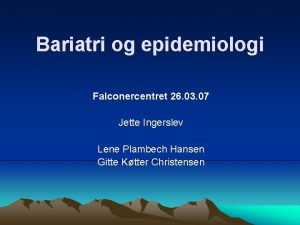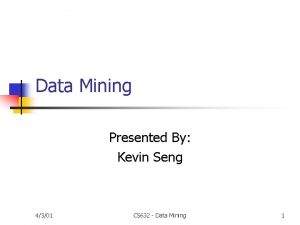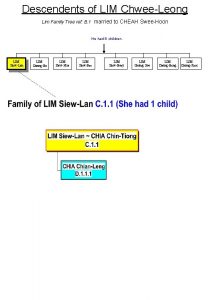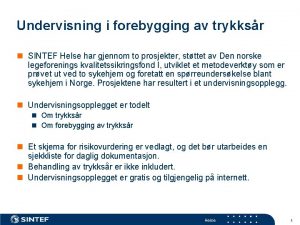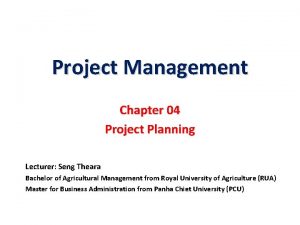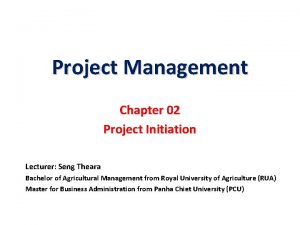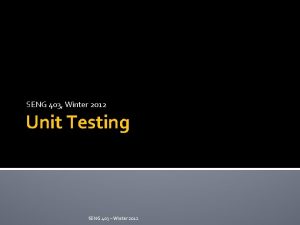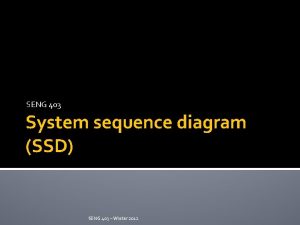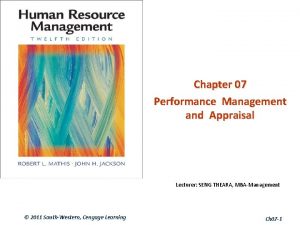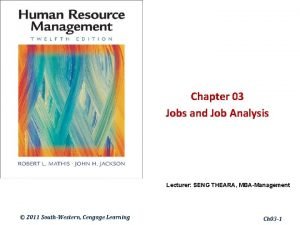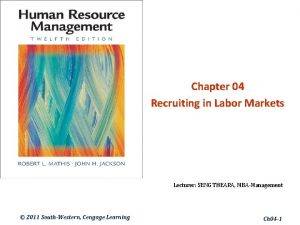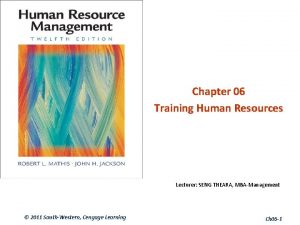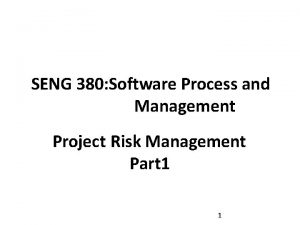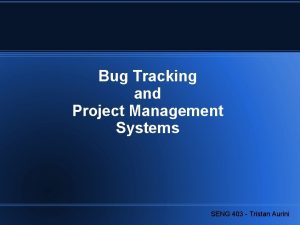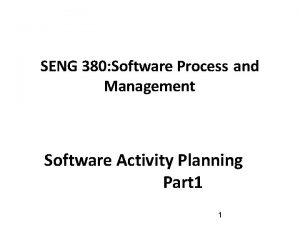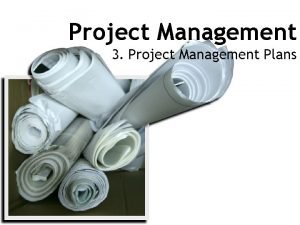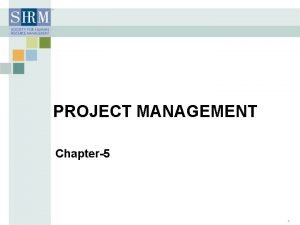Project Management Chapter 03 Project Design Lecturer Seng

























- Slides: 25

Project Management Chapter 03 Project Design Lecturer: Seng Theara Bachelor of Agricultural Management from Royal University of Agriculture (RUA) Master for Business Administration from Panha Chiet University (PCU)

Chapter Objectives 1. Problem analysis 2. Log frame 3 -2

Introduction v. Once a priority community need has been identified, we can start to think about how it can be addressed. Project design consists of: 1. 2. 3. 4. 5. problem analysis log frame risk analysis action planning budgeting 3 -3

Problem Analysis v. Before we can start to design the project, we need to analyze the problem identified during project identification. v. Problem analysis helps primary stakeholders to identify the causes and effects of the problems they face. v. It involves drawing a problem tree, from which project objectives can be identified. 3 -4

Problem Analysis (Cont’d) v. Problem Tree ØProblem trees enable stakeholders to get to the root of their priority need and to investigate the effects of the problem. ØStep 1: Agree on the main problem, usually the one identified during project identification. What is the most priority problem? ØStep 2: Identify the causes of the main problem by asking ‘But why? ’ until we can go no further. 3 -5

Problem Analysis (Cont’d) 3 -6

Problem Analysis (Cont’d) v. Problem Tree ØStep 3: Identify the ‘Effects’ of the main problem (Fruit Analysis). What are the effects of the problem? 3 -7

Problem Analysis (Cont’d) v. Problem Tree ØStep 4: Copy the problem tree onto a sheet of paper. Draw in vertical links to show the relationship between the causes or effects. Combine the root causes and effects (Full problem tree) i. e. another example: 3 -8

Problem Analysis (Cont’d) 3 -9

Problem Analysis (Cont’d) v. Problem Tree ØStep 5 (Turning Problem tree into) Objectives tree üIt looks similar to problem tree but it is more like objectives rather than problems. üIt can be developed with first identifying the problems but it would be easier just to convert it. üCheck the logic! We can add, delete, or change if necessary 3 -10

Problem Analysis (Cont’d) 3 -11

Problem Analysis (Cont’d) Problem Analysis Objective Analysis Effects Goal Focal Problem Project Purpose Causes Output Turning Problem tree into Objectives tree Activities 3 -12

Logical Framework v. What Is Logical Framework (Log frame)? ØThe log frame is a tool used to help strengthen project design, implementation and evaluation. ØThe log frame is a table of four rows and four columns, where all the key parts of a project can be inserted as a clear set of statements: the project goal, purpose, outputs and activities, with their indicators, evidence and assumptions. 3 -13

Logical Framework (Cont’d) Summary Indicators Evidence Assumptions Goal Purpose Outputs Activities Logical Framework 3 -14

Logical Framework (Cont’d) v. Completing Log Frame ØGoal üThe highest level of objectives is the overall objective, which states the direction the project shall take. üIt cannot be expected that this goal will be achieved until possibly some 3 -5 years after the project has ended. üExample 1. Improved health in children. 2. Decreased incidence and impact of diarrhoeal disease. 3 -15

Logical Framework (Cont’d) v. Completing Log Frame ØProject Purpose üThe project purpose is the specific objective that project want to achieve. üIt must be written based on S. M. A. R. T: – – – Specific Measureable Achievable Realistic and Time-bound üEx: Increased access to, and use of, safe water in the diocese. 3 -16

Logical Framework (Cont’d) v. Completing Log Frame ØOutputs üWhat outputs are needed to achieve the purpose? üIn other words, what will the project deliver? üOutputs are what the project team has control over. üExample: 1. Team of healthcare workers strengthened and functioning. 2. Improved sources of safe water. 3 -17

Logical Framework (Cont’d) v. Completing Log Frame ØActivities üHow will we deliver the outputs? üIt is likely that there will be a long list of activities to carry out. üHowever, the log frame should not include too much detail. üExample: 1. Recruit healthcare workers. 2. Upgrade current wells and establish new wells. 3 -18

Logical Framework (Cont’d) v. Completing Log Frame ØAssumptions/risks üExternal factors/Risks – These are risks that exist outside the framework of the project (for example political developments, natural disasters, corruption etc. ) – It is most often the case that the project group cannot exert an influence on these risks. üInternal factors/ Risks – These are risks of the type that are possible for inside of organization include staff’s ability, shortage of time, and lack of communication. 3 -19

Logical Framework (Cont’d) v. Completing Log Frame ØEvidence üEvidence is called ‘Means of Verification’ in some log frames. üIt describes the sources of information we will use to measure the indicator. üIn log frame should considers: – The type of data needed, such as a survey – The source of the data; secondary and primary data; who collect this data. – Frequency and dates of data collection, example, monthly, quarterly, annually. 3 -20

Logical Framework (Cont’d) v. Completing Log Frame ØIndicators üIs the project achieving its goals? üTo answer this question, the project group needs to identify indicators, which make it possible to measure the progress of the project at different levels. üThey are signs which measure project performance against objectives and play an important part in monitoring and evaluation. 3 -21

Logical Framework (Cont’d) v. Completing Log Frame ØIndicators üMeasurement can be: – Quantitative: indicators can be analyzed in numerical form: • Number of people involved or affected • Growth rates – Qualitative: indicators measure things that cannot be counted, like: • Satisfaction • Changes in attitude 3 -22

Logical Framework (Cont’d) v. Completing Log Frame ØIndicators üMeasurement can be: – Direct indicator is measure the objective directly. • Numbers of participant • Numbers of children attending school – Indirect indicator is used if direct indicators are not appropriate or possible if, for example: • Quality of life • Tin roofs on house 3 -23

Logical Framework (Cont’d) v. Completing Log Frame ØIndicators üTypes of indicators – Goal level indicators • The indicators at goal level may reach beyond the end of the project. • They might not be measured by our organization, but be included in government statistics some months after the project has ended. – Purpose level indicators • Indicators can be difficult to identify at purpose level. This is because the purpose objective often defines a change in behavior, which can be difficult to measure. 3 -24

Logical Framework (Cont’d) v. Completing Log Frame ØIndicators üTypes of indicators – Output level indicators • Output indicators should be easier to measure than higher level objectives, because we have more control over these objectives. – Activity level indicators • The clearest indication of whether activities have happened successfully is if the outputs have been delivered. 3 -25
 Lecturer's name
Lecturer's name Jeannie watkins
Jeannie watkins Spe distinguished lecturer
Spe distinguished lecturer Good morning teacher good morning teacher
Good morning teacher good morning teacher Photography lecturer
Photography lecturer Lecturer in charge
Lecturer in charge Designation lecturer
Designation lecturer Designation of lecturer
Designation of lecturer Why himalayan rivers are pernnial in nature
Why himalayan rivers are pernnial in nature Lecturer name
Lecturer name Pearson lecturer resources
Pearson lecturer resources 140000/120
140000/120 Lector vs lecturer
Lector vs lecturer Lecturer in charge
Lecturer in charge Cfa lecturer handbook
Cfa lecturer handbook Lecturer asad ali
Lecturer asad ali Ttsh rehabilitation centre
Ttsh rehabilitation centre Joshua seng
Joshua seng Yeo hiap seng family tree
Yeo hiap seng family tree Bariatri kørestole
Bariatri kørestole 130 seng
130 seng Kevin seng
Kevin seng Loh boon siew family tree
Loh boon siew family tree Eid milad majid
Eid milad majid Braden skala skjema
Braden skala skjema Chan beng seng
Chan beng seng



















